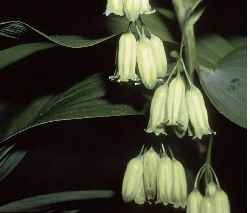Great Solomon's Seal
Scientific Name: Polygonatum biflorum var. commutatum (J.A. & J.H. Schultes) Morong
Synonym: Convallaria commutata, Polygonatum canaliculatum, Polygonatum commutatum
Family: Convallariaceae
Sunset®: 1-7,15-17
USDA: 3-8
Sun Exposure: Light shade to shade
Origin: Eastern North America, in moist woodlands
Growth Habits: Herbaceous perennial, 2 to 6 feet tall (60-180 cm), 18 to 24 inches spread (45-60 cm)
Flowers: Greenish flowers
Watering Needs: Frequent water, moist air, tolerates wet soils
Propagation: Spreads by rhizomes, division of rhizome in spring, seeds

Polygonatum commutatum flowers, Robert H. Mohlenbrock. USDA NRCS. 1995. Northeast wetland flora: Field office guide to plant species.
The rhizomes are edible, starchy.

Polygonatum commutatum, Britton, N.L., and A. Brown. 1913. Illustrated flora of the northern states and Canada. Vol. 1: 521.
Blooming Habits:
Greenish white, bell-shaped, 0.6 to 1.2 inches long (1.5-3 cm), usually borne in more than 2s below arching stems, in May and June. The fruits are blue-black berries ripening in the fall, up to 0.6 inch (1.5 cm) in diameter. The berries are slightly toxic.
Desert-Tropicals is dedicated to provide gardening advice, gardening ideas, and information about flower of all kind for landscape and collections.We try to check carefully the identification of the plants on the illustrations as well as the other information from the page, but occasionally errors do occur. if you notice anything that needs to be changed please contact us.Thanks.
© 1998-2020 Philippe Faucon, All Rights Reserved.